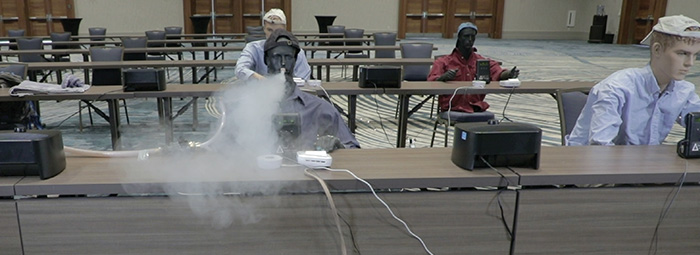
© 2021 This excerpt taken from the article of the same name which appeared in ASHRAE Journal, vol. 63, no. 10, October 2021. This peer-reviewed article does not represent official ASHRAE guidance. For more information on ASHRAE resources on COVID-19, visit ashrae.org/COVID19
About the Authors
Zhiqiang (John) Zhai, Ph.D., is a professor at the University of Colorado at Boulder in Boulder, Colo. He is a member of ASHRAE TC 4.10, Indoor Environmental Modeling. Robert Bahl is Global Vice President of Engineering & Facilities, and Keith Trace is Senior Director of Engineering & Facilities at Marriott International, Inc. Bhavesh Gupta is Director of Engineering, Healthy Buildings and INNCOM for Honeywell International. He Li, Ph.D., is a lecturer at the University of Shanghai for Science and Technology, China.
What can the hospitality industry do to reduce the risk of transmission of COVID-19? Part is recognizing that HVAC systems play a role in mitigating the risk of airborne transmission of COVID-19. At the beginning of the pandemic, hospitality facilities, including hotels and restaurants, quickly aligned with guidance from the CDC, WHO and other credible organizations such as ASHRAE by adjusting operating guidelines to increase outdoor air dilution and improve filtration, where possible, while maintaining guest and associate comfort. This article discusses a comprehensive study recently conducted by the authors to investigate the efficacy of portable air purifiers to improve air quality in public spaces.
Improving filtration can be accomplished by using filters with higher MERV ratings. For instance, high-efficiency particulate air (HEPA) filters are effective in removing “99.97% or better for all particle sizes.” However, filters with higher ratings may increase the pressure drop, which may make them impractical for some applications. And, even the most efficient filters in a centralized HVAC system potentially do not mitigate heavier droplets or other particles that do not get entrained into the return air vents and may float around a given space.
Increasing the amount of outdoor air the system delivers can further dilute particle concentration and transmission risks. However, outdoor conditions such as temperature, humidity and air quality can limit the amount of outdoor air that can be introduced while maintaining occupant comfort levels.
Building codes and regulations outline the requirements for ventilation, and hotel heating and air-conditioning systems are designed to meet these standards. However, they were not designed to increase this significantly. Also, hotel guest room heating and air conditioning systems should be designed with slight positive pressure, so air does not pass from one room to another.
Another way to increase the ventilation is by leveraging air purifiers to provide equivalent air exchanges through filtration and circulation. The EPA has stated, “Consider using portable air cleaners to supplement increased HVAC system ventilation and filtration, especially in areas where adequate ventilation is difficult to achieve.” One CDC example concluded that “adding the portable HEPA unit increased the effective ventilation rate and improved room air mixing, resulting in an 80% reduction in time for the room to be cleared of potentially infectious airborne particles.” Another study for a reception setting showed “high-volume HEPA filtering decreases [the individual risk of infection] by a factor of ten.”
For our comprehensive study, computational fluid dynamics (CFD) models such as the one in Figure 1 were developed to simulate airflow patterns while people were breathing and talking in public spaces under normal conditions. Portable air purifiers were introduced into the models to analyze the benefits and determine their optimal number and locations. Field experiments using thermal mannequins were also carried out to validate and visualize the cleaning performance of portable air cleaners.
Read the Full Article
ASHRAE Members have free access to the full-text PDF of this article as well as the complete ASHRAE Journal archives back to 1997 in the Free Member Access Area.
Non-members can purchase features from the ASHRAE Bookstore. Or, Join ASHRAE!
Return to Featured Article Excerpts
Return to ASHRAE Journal Featured Article Excerpts